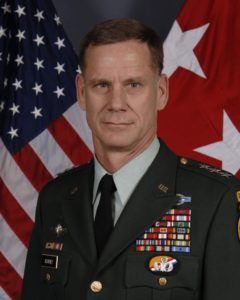Strategic Decision-Making: April 19, 2021
Title: Military Processes: “How to Think, Not What to Think”
Presented By: Francis H. Kearney III, Lieutenant General, US Army (Ret.); President of Inside Solutions LLC; Former Senior Special Operations Forces Commander, Center for Naval Analysis; Former Deputy Director for Strategic Operational Planning, National Counter-Terrorism Center
Description: The United States Army concept of Mission Command recognizes that operations across the globe will be distributed, decentralized, locally impacted, rapidly changing, yet integrated to achieve outcomes desired and driven by national and regional whole of government strategies. This requires a leadership and planning framework that focuses on how to think, not on what to think. Mental agility and empowerment are critical to executing the Leader’s Intent as changing conditions and variables will ensure no plan will be executed without adjustments. DISCIPLINED PROCESSES, CREATE AGILE ORGANIZATIONS
Learning Outcomes:
- Participants will be able to understand the concept of Mission Command and its key tenets
- Participants will be able to demonstrate understanding of the Military Decision Making Process and two of its key elements: Leader’s Intent and Briefbacks
Leader’s Intent is a core concept in Mission Command; leaders tell their teams what the mission is, why the task is important (purpose), some key tasks required to achieve success and describe what success looks like (end state). The leader does not tell the team how to conduct the mission; the team reflects back to the leader their understanding of the mission in a ‘confirmation brief’, then analyzes the situation, develops courses of action and gives the leadership a ‘backbrief’ on plan which communicates how to achieve the Leader’s Intent. Using Leaders Intent without a confirmation brief and plan backbrief is a risky endeavor; so the three processes are linked.
- Participants will be able to understand the concept of organizational learning: The After Action Review
The Army uses a process called the After Action Review. It is done as soon as possible after execution of a task, project or phase of a project. It is disciplined discussion focusing on 4 questions: What was the plan? What did we actually execute? What did we learn? What element has responsibility for implementing lessons learned? Who else needs to know?
Biography: Lieutenant General Frank Kearney retired on 1 January 2012 from the United States Army after more than 35 years of service. His final active duty assignment was Deputy Director for Strategic Operational Planning at the National Counter-Terrorism Center in Washington DC. General Kearney now serves as the President of his own consulting company, Inside-Solutions-LLC focusing on leader development in organizations. Most recently he served as the Interim CEO and President of Draper Laboratories in Cambridge MA from March to mid October 2020.
He works routinely with Thayer Leadership at the Thayer Hotel at West Point, NY and with military and corporate groups to assist in improving organizational performance through leader development. In this capacity he has worked with leaders in 7-11, Deloitte, Mercedes-Benz USA, General Electric, USAA, Novartis, Madison Square Garden, China-Europe International Business School, Morgan Stanley, Lord Abbett, BorgWarner, Synchrony Bank and many others. General Kearney serves as the Chairman of the Advisory Board for Team Red, White and Blue, a non-profit that helps reintegrate wounded warriors into their communities through physical and social activities, as well as on the Board of Directors for Draper Laboratories, and the advisory boards for Red Gate Group, Xtreme Precision Firearms, Reperi, Westport Construction, and Academy Securities.
General Kearney is a routine speaker on Terrorism, Interagency, Defense and Security issues. He was a congressionally appointed member of National Defense Panel to assess scenarios, recommendations and conclusions for the 2014 Quadrennial Defense Review (QDR). General Kearney also serves as a Distinguished Faculty Member of the Joint Special Operations University at USSOCOM and as a mentor to the Department of State Foreign Service Institute in Washington DC. He is a Senior Special Operations Fellow at the Center for Naval Analysis, an FFRDC in Washington DC.
General Kearney is a 1976 graduate (BS) of the United States Military Academy and a 1985 graduate (MEd) of the University of South Carolina. He is a graduate of the US Army Command and General Staff College as well as the United States Army War College. He has served in operational and command assignments at every level with combat tours in Grenada, Panama, Bosnia, Iraq and Afghanistan, including combat parachute assaults into Grenada and Panama. General Kearney’s most recent assignments at the strategic and operational level focused on Special Operations and Counter-Terrorism. He planned and participated in the opening campaigns of Operation Enduring Freedom in Afghanistan and Operation Iraqi Freedom in Iraq and commanded all Theater Special Operations forces in the middle-east including OIF and OEF from March 2005 to June 2007. General Kearney also served as the Deputy Combatant Commander for United States Special Operations Command (SOCOM) from 2007-2010 and insured that the 62,000 operators of this command were properly trained and equipped for their global special operation’s missions. General Kearney oversaw the SOCOM requirements process, the execution of a 10 billion dollar budget and led the SOCOM Quadrennial Defense Review (QDR) team for the 2010 QDR.
General Kearney also sat on the DOD Ballistic Missile Defense Review Committee and the Deputy Secretary of Defense’s Advisory Working Group managing the Defense Department’s annual budget approval and execution. Finally, at the National Counter-Terrorism Center, General Kearney worked with 16-29 different cabinet level agencies in the US government to plan and coordinate the whole of government efforts to achieve the goals of the Obama Administration’s Counter-Terrorism strategy. His team coordinated key implementation plans against terrorist groups and assessed the efforts to achieve stated goals as well as provided input to the Office of Management and Budget on funding priorities for the national counter-terrorism budget.















































